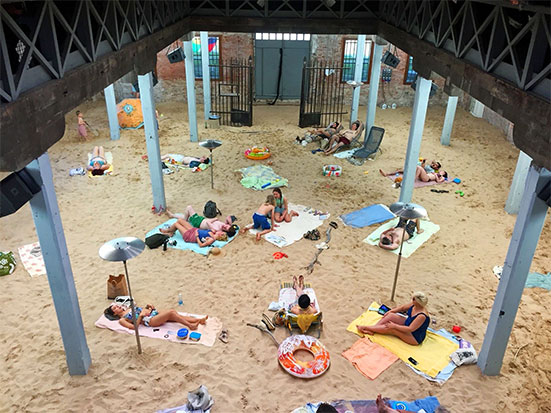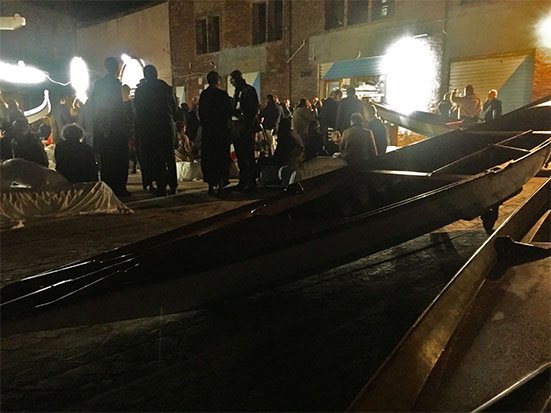One step on from ‘Confucius, he say…’ and two from racist Chinese dentist jokes that end ‘two thirty’ May you live in interesting times is a faux-Oriental curse and the title of the 2019 Venice Biennale curated by Ralph Rugoff. Interesting being a synonym of course, for ‘bit shit’ – as anyone who has ever resorted to using the adjective, (and an overly upbeat tone) to tell a friend what you think of their painting. A fair assessment and ideal vehicle.
The immersive Interesting experience was also ramped-up this year. There were more police, with bigger guns and greyer uniforms - I prefer my Italian police to have braid and caps and gold buttons, so this was disappointing. It also felt like there were more people – on top of the usual press corp and professionals it was possible buy a special, because I want to, card for $300. This had ‘Entitled’ written on it and gave you a gold aura and made the holder special; like they didn’t know that already.
And the queues. Impressively unstructured and fluid these altered from a pub-type arrangement where everyone stood along the counter, demanded free espressos and stared hard at cheerful, young locals gamely working on the Illy stand (I heard an accusation of ‘favouritism’ at one), to the toilets which were either remained classically gender specific or had been repurposed as ‘mixed use’ by the queue (and aggressively policed either way). For the pavilions queues of 2 hours were not unknown and the rules here appear to be similar to rummy (or mahjong): if two or more elements of a given set are currently in the queue it is permissible for other members of the same set to arrive at the last moment and join the ‘meld’. And thus we slowly move ‘post queue’, to a period and anarchy and chaos…
And also the drizzle. See: umbrellas.
The Arsenale was cleverly arranged to disguise the beautiful, airy space and force everyone down narrow, claustrophobic corridors where the sculpture was kept. Occasionally these opened out into cavernous rooms showing massive, multiscreen projections, with metallic, bleepy computer soundtracks. To add to the complexity of navigation the information about the work was positioned in the doorways – cunning (although they missed at trick putting them at 14000mm, knee-high would have been far more fun). There were some strong standout works too; early on Ed Atkins installation of theatrical costumes and video works, one of which was endlessly scrolling credits over rubbery, animated people for a work that never came. Great to see second assistant accountants finally getting some credit though and it has got to be a good move to keep the armorer on side. Then back around the corner, through the black curtain and straight into the elegant, low lit sound work of Shilpa Gupta, which whispered banned texts from hanging speakers.
And so we threaded our way along – past some inverted aircraft landing gear and a massive ‘brace, brace’ figure made of kitchen implements and old clothes by Yin Xiuzhen, and brutal, brutalist photos of the locked gates out of Palatine, titled the Gates of Heaven by Rula Halawani. Generally there was less work than usual requiring heavy tech and so smaller, quiet stuff – knitted, woven, crafted with skill. And prothetics, there was some strong work addressing disability too. The deal was that if you had a work in here you had to put something completely different (ish) in the pavilion-formally-known-as the-Italian in the Giardini – so that was a fun game for the kids. Yes, the marble chair that whipped itself loudly with a rubber tube every few minutes was the sibling of instagramtastic scrapey blood machine, that’s easy, however Ed Atkins has done painting of creepy spiders and Shilpa Gupta was showing a fantastically violent metal gate that flung itself back and forth, slowly destroying the breezeblock wall behind it – lots of points for spotting that pairing.
Elsewhere in the pavilions the work ranged from sensitive and thoughtful (Cathy Wilkes in Great Britain and Weather Report: Forecasting Future – The Nordic Pavilion, to end-of-pier spooky-horror (Russia and Belgium) with sludgy grey, neon and clunky, stairy-eyed automata.
The stand-out of 2019 was Lithuania which rightly won Best Of Show. Sun and Sea (Marina) is an opera composed by Lina Lapelytė with a libretto by Vaiva Grainytė and directed by Rugilė Barzdžiukaitė. Those lucky enough to wander in without expectation walked up some stairs in an old wooden exboat building shed. From a darkened gallery that went around all four sides of first floor it was possible to gaze down on a brightly lit beach scene, where swimming costume-clad sunbathers of all ages lay, children played and dogs slept. The bathers were subtly miked up and singing an opera that detailed their thoughts and daydreams – ‘I must get gas’ from one, to the musings of a workaholic in the opposite corner. A sublime work that was easy to get lost in.
The other work receiving great word-of-mouth reviews was Laure Provost in France. Her signature style benefitting from the budget and space – resin floors with beautifully-produced glass bric-a-brac interspersed with small, absurd performances accompanied a dreamy/grubby comedown road-trip film of molluscs, grottos and brass quartets. The basement through which we entered contained the earthworks of a tunnel, apparently toward the British pavilion, perhaps a gesture of friendship, or perhaps, in these ‘interesting times’ because there is a toilet in the basement, and the queue is shorter over there so it is a win/win for those with the right card/connections.
Adrian Lee

Lithuanian Pavilion, Sun and Sea (Marina)
Photo: Adrian Lee

Madagascar Pavilion Launch Party
Photo: Adrian Lee